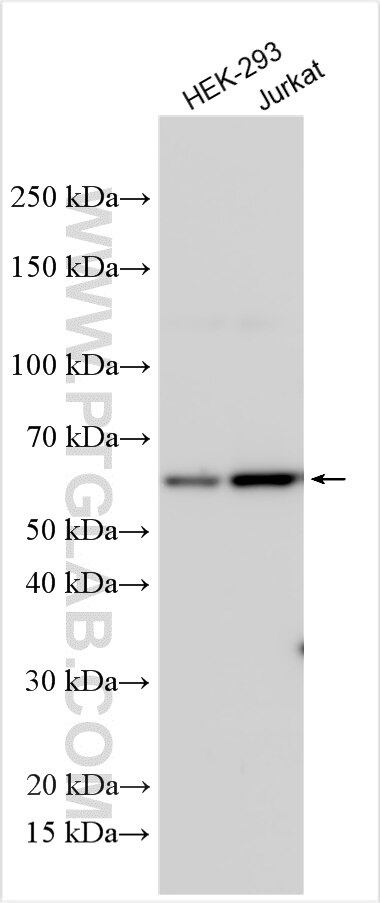Tested Applications
| Positive WB detected in | HEK-293 cells, Jurkat cells |
Recommended dilution
| Application | Dilution |
|---|---|
| Western Blot (WB) | WB : 1:1000-1:8000 |
| It is recommended that this reagent should be titrated in each testing system to obtain optimal results. | |
| Sample-dependent, Check data in validation data gallery. | |
Product Information
24887-1-AP targets TTC39C in WB, ELISA applications and shows reactivity with human samples.
| Tested Reactivity | human |
| Host / Isotype | Rabbit / IgG |
| Class | Polyclonal |
| Type | Antibody |
| Immunogen | TTC39C fusion protein Ag21680 Predict reactive species |
| Full Name | tetratricopeptide repeat domain 39C |
| Calculated Molecular Weight | 583 aa, 66 kDa |
| Observed Molecular Weight | 65 kDa |
| GenBank Accession Number | BC121034 |
| Gene Symbol | TTC39C |
| Gene ID (NCBI) | 125488 |
| RRID | AB_3669458 |
| Conjugate | Unconjugated |
| Form | Liquid |
| Purification Method | Antigen affinity purification |
| UNIPROT ID | Q8N584 |
| Storage Buffer | PBS with 0.02% sodium azide and 50% glycerol, pH 7.3. |
| Storage Conditions | Store at -20°C. Stable for one year after shipment. Aliquoting is unnecessary for -20oC storage. 20ul sizes contain 0.1% BSA. |
Background Information
Tetratricopeptide repeat protein 39C (Ttc39c) is a protein-coding gene located on the long arm of chromosome 18. The protein encoded by the Ttc39c gene contains several putative tetrapeptide repeats (TPR) domains, which form a structural motif that promotes protein-protein interactions. The TPR domain affects cell cycle regulation and signal domain. TTC39C is involved in the progression of various tumors (PMID: 31188487, PMID: 36303158).
Protocols
| Product Specific Protocols | |
|---|---|
| WB protocol for TTC39C antibody 24887-1-AP | Download protocol |
| Standard Protocols | |
|---|---|
| Click here to view our Standard Protocols |



